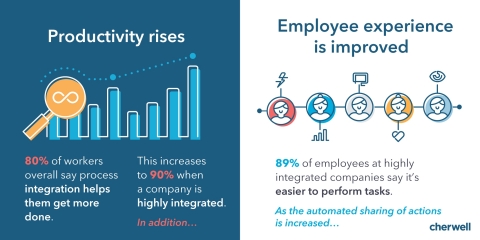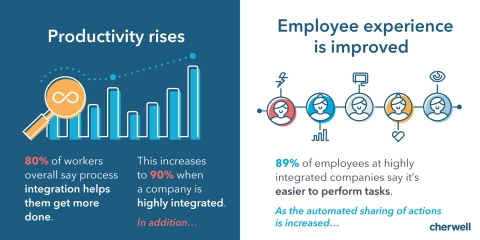COLORADO SPRINGS, Colo.--(BUSINESS WIRE)--Cherwell Software, LLC, (“Cherwell”) a global leader in service management, released the results of a new study, “The Power of Process Integration in the Information Age,” revealing that even large companies are not yet realizing the potential of digital transformation.
In a survey of more than 1,000 U.S. information workers, including 500 managers and executives, only about one-quarter (27%) indicate that their day-to-day processes are “highly integrated.” In other words, manual processes and lack of cross-functionality still abound in today’s workplace. However, those who report high levels of integration also report the highest levels of productivity, engagement, and satisfaction.
“The findings of this study are consistent and clear: information workers don’t just need technology, they need connective tissue between teams, departments, partners, and customers,” said Sam Gilliland, chief executive officer of Cherwell Software. “Companies that are able to connect work processes into logical, automated workflows – through a service management architecture – stand to greatly improve productivity and employee experience.”
Where is Transformation Stalled?
Among the challenges facing information workers today, respondents to the April 2019 study conducted by Lawless Research report that manual and disconnected processes are prevalent as is a lack of training and cross-functional leadership. Nearly half (43%) of those surveyed reported spending at least half of their workday on manual processes and more than a third (34%) said they found it difficult to use applications that involved multiple departments, applications, or data sources.
-
When asked about nine typical work processes for an information worker, nearly 70% said that the processes were moderately to highly manual, with the most manual being:
- onboarding/offboarding an employee (86%)
- resolving customer issues (also 86%)
- conducting performance reviews (85%), and
- participating in cross-functional projects (also 85%)
- 34% of respondents said that they found it difficult to use applications that involve multiple departments, applications, or data sources.
-
The majority of managers and executives (94%) expressed frustration arising from different teams using different applications.
- The “most frustrating issues” in this context are: inefficiencies (cited by 43% of managers), repetitive work (40%), miscommunication (37%), errors (27%), and software incompatibility (26%).
Why Should Companies Care and What Can be Done?
The survey reveals that companies that do have highly integrated cross-functional processes stand to reap the benefits of increased productivity, process improvement, and cross-functional cohesion. Importantly, workers who report that their companies are highly integrated also report significantly higher workforce satisfaction and engagement.
Higher Integration Leads to Higher Engagement
-
Employees were asked about the intangible benefits from integrated work processes they experience. Among the responses from employees in highly integrated companies:
- 90% said they could get more done
- 89% said it was easier to perform tasks
- 87% said it was easier to work with others
- 71% said they enjoyed their job more
- 64% said they had more opportunity for professional growth
- 54% said it was easier to stay on budget
Boosting Productivity and Collaboration
- 61% of respondents from companies whose level of process integration was high said that the apps and software they used for their jobs increased their productivity either considerably or a great deal. The corresponding percentages for companies with medium and low levels of integration were dramatically lower—35% and 26%, respectively.
Additional Resources
Survey Methodology
Cherwell commissioned Lawless Research, one of the world’s preeminent thought leadership market research firms, to conduct a first-of-its-kind survey of 1,000+ information workers.
The 10‑minute online survey was fielded between April 16 and April 22, 2019 in the U.S. A total of 1,045 information workers completed the survey. Dynata provided respondents from their B2B panel. Tests of significance were conducted at the .05 level (95% probability that the difference is real, not by chance).
About Lawless Research
Lawless Research, an expert in market research for the tech industry, provides companies with the business intelligence they need to make informed strategic decisions. Our rigorous and comprehensive studies help tech companies become thought leaders in their industries, build brand awareness, increase customer retention, design successful products, and grow their business worldwide. www.lawlessresearch.com
About Cherwell Software
Cherwell (@Cherwell) empowers organizations to transform their business through the rapid adoption and easy management of digital services. Cherwell’s adaptable platform has enabled thousands of organizations to modernize their business operations with customizable service management, automation, and reporting across the enterprise. For more information, visit: http://www.cherwell.com.




